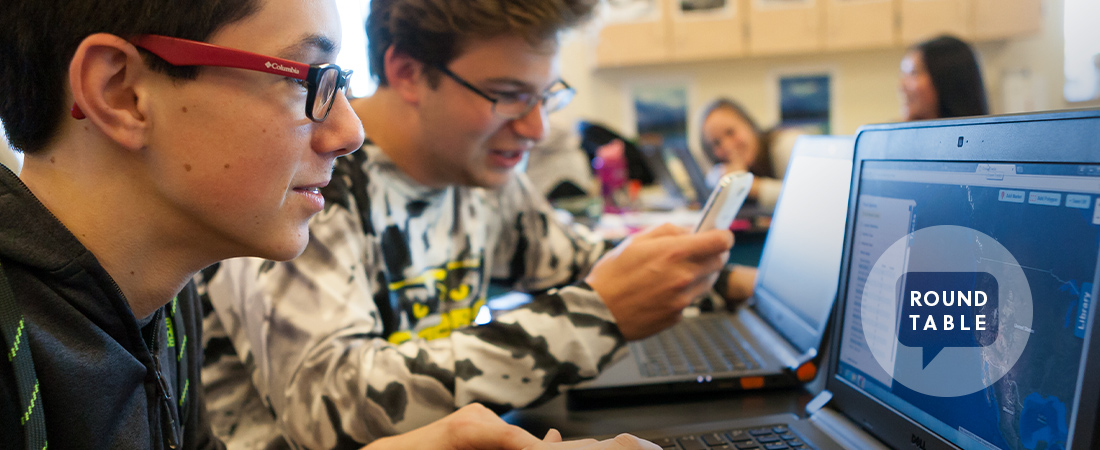Are We Doing Enough to Teach Students to Be Data Literate?

If there’s one thing that’s certain about the workforce of the future, it’s that the need for data literacy skills will only continue to grow. Humans are creating—and collecting—data at an unprecedented rate, and the way these data are analyzed has significant consequences for everything from economics to health to social policy. But are schools doing enough to prepare students for this data-heavy future?
EDC’s Megan Silander, Jo Louie, and Randy Kochevar are all working to improve data literacy in K–12. They recently shared their insights on why data literacy is so essential today, and what teachers can do to create students who are ready for the future.
Q. Let’s start with a quick definition. How do you define data literacy?
Kochevar: In 2015, Oceans of Data Institute and IBM worked with data scientists and educators to define data literacy. We came up with the following definition: “The data-literate individual understands, explains, and documents the utility and limitations of data by becoming a critical consumer of data, controlling his/her personal data trail, finding meaning in data, and taking action based on data. The data-literate individual can identify, collect, evaluate, analyze, interpret, present, and protect data.”
Q. So in practice, what does that mean?
Kochevar: Data literacy is more than just the math techniques needed to process sets of data. It’s also the habits of mind and the technical skill set that allows people to approach and solve a real-world problem through the use of data.
Louie: I work closely with statisticians in my projects, and many of them would argue that a data literate person needs to possess core abilities to think and reason statistically to make sense of quantitative data. This includes having knowledge of basic statistical language and tools to discern and describe quantitative patterns in data. Data-literate people also need to understand the nature of the data under study—such as what concepts they measure, what contexts they address, and what questions they can answer—all in order to interpret and make valid claims from data.
Q. We’re living through an era of rapid technological and scientific change. Many of today’s students will be working at jobs that haven’t even been invented yet. How does data literacy fit in to that?
Silander: I see data literacy as more than just a workforce development issue. We need people who understand how to grapple with the challenges created by living in a society where algorithms are used to make more and more decisions—from what you see on your Facebook feed to whether you get a loan. There’s evidence that algorithms reinforce social biases because the people who create the algorithms are biased. What does that mean for women, people of color, and others who have historically been marginalized in the United States? For me, emphasizing data literacy in school is an issue of civil liberties, of civics.
Louie: Over the past 15 years, statistics educators have issued guidelines recommending data skills all students should learn. They suggest that students should learn to seek out where data come from, understand that data are measurements, and recognize that data analysis requires making sense of the variability within data. Data are also always about something; they’re not just numbers on a page. So when Megan talks about data literacy skills being essential for an informed citizenry, I think that’s precisely right.
Q. Let’s go back to the classroom. Do you think schools are doing enough to teach data literacy?
Kochevar: No. The examples that math teachers use to teach data literacy are often convenient for teaching the specific calculation techniques that they are talking about. They aren’t necessarily interested in teaching a course on social justice or climate change or any of the authentic topics you might use data for.
Louie: Right. But we’ve also seen that when social studies or history or science teachers try to teach data literacy, they face challenges as well. They may not be comfortable supporting students’ learning of statistical concepts and data practices. And all teachers face pressure to just get through their required curriculum.
Silander: In New York, where we have tried to recruit teachers to pilot some of our data-based science materials, teachers are concerned about making sure their kids can pass end-of-year state exams. And data literacy isn’t assessed on that exam. The reality is that accountability pressures are forcing teachers’ hands. Teachers have a lot on their plates already. If we want teachers to teach data literacy, we have to make it easy and fun for them to do.
Kochevar: It really points to a weakness in the education system, doesn’t it? When a subject like data literacy comes along that is inherently multidisciplinary and interdisciplinary, everybody is feeling like, “I don’t know how to make this happen.”
Q. So you all agree that data literacy needs to be taught, but that it doesn’t fit neatly into any one discipline. Given that, how can we improve data literacy instruction?
Silander: Professional development is a key piece, and so is helping administrators understand how important data literacy is. Also, teachers don’t know where to find data sets and analytic tools that they can easily use in their classroom. There’s not enough out there right now. But I think each of us is trying to fix that problem.
Kochevar: With our Oceans of Data work, we infuse data analysis into specific units within specific courses. So in an Earth science class, you have to teach plate tectonics. In biology, you have to teach evolution. We are trying to build units that provide authentic data so the teacher can teach the same concepts as before, but maybe now they can also work in some data literacy skills as well.
Louie: In Massachusetts, where it’s recommended that all high school students take four years of mathematics, we have found that there is a thirst for materials and curricula that will engage students who are not taking pre-Calculus or an AP mathematics course in that fourth year. So we’ve been creating materials that approach issues of social justice through data and statistics. These topics relate to students’ lives, and students have been very engaged by our materials.
Q. And finally, what tips do you have for teachers who want to begin integrating data literacy into their teaching?
Silander: Randy and I have been working together on building lessons on Earth science and biology that incorporate data literacy. So I think that’s a great place to start!
Louie: I’d also add that school principals and department heads can promote data literacy by fostering more collaboration across disciplines. We’ve talked about how data always have a context. To make sense of data, students need to learn mathematical and statistical practices as well as the social studies, science, health, or other contexts underlying the data. Creating these interdisciplinary connections can be tough, but it’s one way to promote more data literacy within schools.
Kochevar: Individual teachers can elevate data literacy by digging into whatever graphs or charts they use in class. They can ask students, where did the data come from? How are they being represented? Why are they being presented this way instead of a different way? It’s that critical-thinking piece. It’s not a bad starting point, and it’s something a teacher could begin doing today without having to change their entire course.


